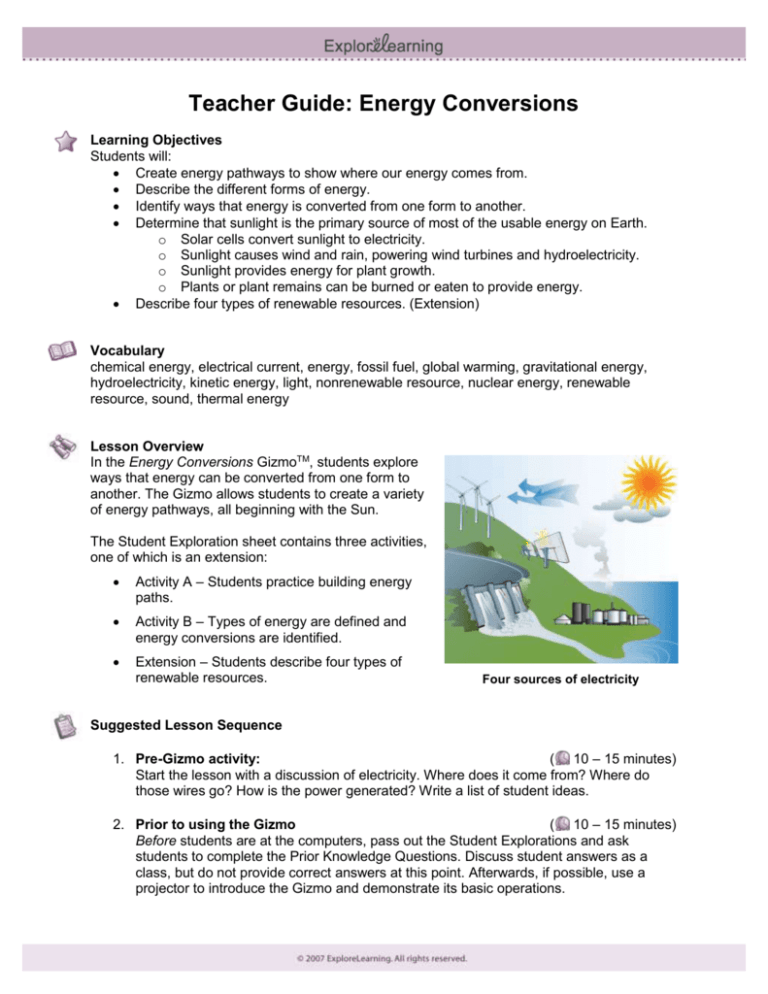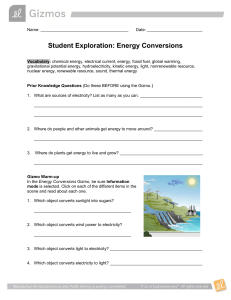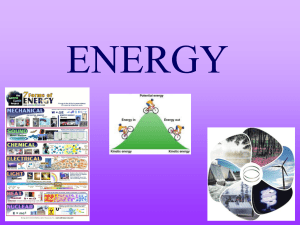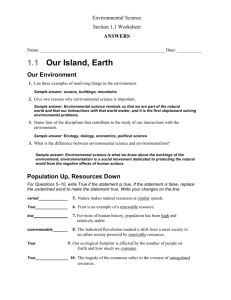Teacher Guide
advertisement

Teacher Guide: Energy Conversions Learning Objectives Students will: Create energy pathways to show where our energy comes from. Describe the different forms of energy. Identify ways that energy is converted from one form to another. Determine that sunlight is the primary source of most of the usable energy on Earth. o Solar cells convert sunlight to electricity. o Sunlight causes wind and rain, powering wind turbines and hydroelectricity. o Sunlight provides energy for plant growth. o Plants or plant remains can be burned or eaten to provide energy. Describe four types of renewable resources. (Extension) Vocabulary chemical energy, electrical current, energy, fossil fuel, global warming, gravitational energy, hydroelectricity, kinetic energy, light, nonrenewable resource, nuclear energy, renewable resource, sound, thermal energy Lesson Overview In the Energy Conversions GizmoTM, students explore ways that energy can be converted from one form to another. The Gizmo allows students to create a variety of energy pathways, all beginning with the Sun. The Student Exploration sheet contains three activities, one of which is an extension: Activity A – Students practice building energy paths. Activity B – Types of energy are defined and energy conversions are identified. Extension – Students describe four types of renewable resources. Four sources of electricity Suggested Lesson Sequence 1. Pre-Gizmo activity: ( 10 – 15 minutes) Start the lesson with a discussion of electricity. Where does it come from? Where do those wires go? How is the power generated? Write a list of student ideas. 2. Prior to using the Gizmo ( 10 – 15 minutes) Before students are at the computers, pass out the Student Explorations and ask students to complete the Prior Knowledge Questions. Discuss student answers as a class, but do not provide correct answers at this point. Afterwards, if possible, use a projector to introduce the Gizmo and demonstrate its basic operations. 3. Gizmo activities ( 10 – 15 minutes per activity) Assign students to computers. Students can work individually or in small groups. Ask students to work through the activities in the Student Exploration using the Gizmo. Alternatively, you can use a projector and do the Exploration as a teacher-led activity. 4. Discussion questions ( 15 – 30 minutes) As students are working or just after they are done, discuss the following questions: What are the different forms of energy displayed in the Gizmo? Why is the Sun needed to produce hydroelectric power from dams? Why is the Sun needed to produce wind power? Why is the Sun needed to produce power from ethanol? How are electrical currents generated? How is a solar cell similar to a plant like corn? How is a light bulb similar to a toaster? (Extension) Less than 20% of the total energy we use comes from renewable energy sources (such as nuclear power). If renewable energy doesn’t run out, why isn’t it used more? 5. Follow-up activity: Energy conversions in the school ( 20 – 30 minutes) Go around your classroom and your school. Find examples of energy conversions. For example, a window fan converts electrical energy to kinetic energy and sound. A car converts chemical energy to sound, thermal energy, and kinetic energy. A flashlight converts chemical energy to electrical energy, and then converts that to light and thermal energy. A person converts chemical energy to kinetic, sound, and thermal energy. Assign students (individuals or groups) research projects on renewable sources of energy such as wind power, solar power, hydroelectricity, nuclear power, geothermal energy, or ethanol. Each group can present their findings in one or two weeks. See Selected Web Resources for some good beginning websites. Scientific Background Scientists usually define energy as the ability to do work or cause changes. According to the principle of conservation of energy, energy can be converted from one form to another but cannot be created or destroyed. Consider a ball rolling to a stop because of friction. The kinetic energy of the moving ball is converted to thermal energy in the ball and the surface it is rolling over. (Friction causes both the ball and the surface to heat up slightly.) Energy can also be converted into gravitational potential energy, sound, light, electrical current, chemical energy, and nuclear energy. A key step in providing electrical power is converting kinetic energy to electrical current. A generator is used to do this. Outside a generator, a turbine spins a shaft. The turbine may be powered by wind, flowing water, or steam heated by the burning of fuel. Inside the generator, the shaft is attached to a loop of wire that rotates within a magnetic field. In a process called electromagnetic induction, a current is produced in the wire by the magnetic field. Because the current switches direction every half spin, it is known as an alternating current (AC). Many other forms of energy are illustrated in the Energy Conversions Gizmo. For example, in the process of photosynthesis, plants cells convert sunlight to chemical energy by building molecules of sugar and other substances. During cellular respiration, animal (or plant) cells break these molecules apart to release the stored energy. If this occurs in a muscle cell, the chemical energy is converted to kinetic energy and the animal can move around. Environmental Connection – Renewable Energy Evidence is growing that the burning of fossil fuels causes global warming, with potentially disastrous consequences. The US is a major part of the problem. In spite of comprising less than 5% of the world’s population, the US supplies almost 20% of the world’s carbon dioxide emissions. In the past 30 years, American energy consumption has changed a little but not much. In 2006 about 85% of US energy came from the burning of fossil fuels, down from 95% in 1973. The world average is 80%. Clean energy sources such as wind and solar power account for less than 1% of the US’ total energy production. Energy sources in the United States (2006) Why so little? The main reasons are cost and a lack of government support. Solar power plants and wind farms are expensive to build, but once built can run for many years at low cost. Unlike the US, many European countries have shown a strong commitment to reducing carbon emissions. Germany produces more than 10% of its energy from wind and solar power; in tiny Denmark wind power accounts for almost one fifth of its energy supply. Japan, another world leader in alternative energy, generates less than half of its energy from fossil fuels. Renewable energy is not free of environmental impact. In China, the nearly-completed Three Gorges Dam will provide power to over 100 million people. But the dam has forced over a million people to relocate, destroyed valuable archeological sites, and could cause great harm to farms and fisheries downriver. Hydroelectricity also wreaks havoc on both aquatic and nonaquatic ecosystems. Do these costs offset the benefits of low-emission energy in a country with some of the world’s most polluted air? It is a difficult question to answer. Selected Web Resources Energy Energy conversions: http://www.usoe.k12.ut.us/CURR/SCIENCE/sciber00/8th/forces/sciber/energy2.htm Energy conversions lesson plan: http://www.uni.edu/earth/EECP/mid/mod2_sc.html Energy activities: http://www.think-energy.co.uk/ThinkEnergy/Default.aspx Energy worksheets: http://www.need.org/needpdf/PrimaryActivitiesStudent.pdf Renewable energy US Department of Energy: http://www.energy.gov/energysources/index.htm DOE kids page: http://www.eia.doe.gov/kids/ Dr. E’s Energy Lab: http://www1.eere.energy.gov/kids/index.html Clean energy (including pages on various renewable energy sources): http://www.ucsusa.org/clean_energy/renewable_energy_basics/energy-101-take-a-tour.html Climate change for kids: http://www.epa.gov/climatechange/kids/







